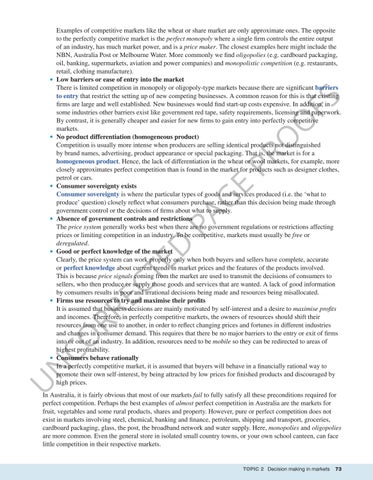“c02DecisionMakingInMarkets_PrintPDF” — 2022/5/25 — 13:13 — page 73 — #7
O
CO RR EC
TE
•
D
•
PA
G
•
E
PR
•
O
FS
•
Examples of competitive markets like the wheat or share market are only approximate ones. The opposite to the perfectly competitive market is the perfect monopoly where a single firm controls the entire output of an industry, has much market power, and is a price maker. The closest examples here might include the NBN, Australia Post or Melbourne Water. More commonly we find oligopolies (e.g. cardboard packaging, oil, banking, supermarkets, aviation and power companies) and monopolistic competition (e.g. restaurants, retail, clothing manufacture). Low barriers or ease of entry into the market There is limited competition in monopoly or oligopoly-type markets because there are significant barriers to entry that restrict the setting up of new competing businesses. A common reason for this is that existing firms are large and well established. New businesses would find start-up costs expensive. In addition, in some industries other barriers exist like government red tape, safety requirements, licensing and paperwork. By contrast, it is generally cheaper and easier for new firms to gain entry into perfectly competitive markets. No product differentiation (homogeneous product) Competition is usually more intense when producers are selling identical products not distinguished by brand names, advertising, product appearance or special packaging. That is, the market is for a homogeneous product. Hence, the lack of differentiation in the wheat or wool markets, for example, more closely approximates perfect competition than is found in the market for products such as designer clothes, petrol or cars. Consumer sovereignty exists Consumer sovereignty is where the particular types of goods and services produced (i.e. the ‘what to produce’ question) closely reflect what consumers purchase, rather than this decision being made through government control or the decisions of firms about what to supply. Absence of government controls and restrictions The price system generally works best when there are no government regulations or restrictions affecting prices or limiting competition in an industry. To be competitive, markets must usually be free or deregulated. Good or perfect knowledge of the market Clearly, the price system can work properly only when both buyers and sellers have complete, accurate or perfect knowledge about current trends in market prices and the features of the products involved. This is because price signals coming from the market are used to transmit the decisions of consumers to sellers, who then produce or supply those goods and services that are wanted. A lack of good information by consumers results in poor and irrational decisions being made and resources being misallocated. Firms use resources to try and maximise their profits It is assumed that business decisions are mainly motivated by self-interest and a desire to maximise profits and incomes. Therefore, in perfectly competitive markets, the owners of resources should shift their resources from one use to another, in order to reflect changing prices and fortunes in different industries and changes in consumer demand. This requires that there be no major barriers to the entry or exit of firms into or out of an industry. In addition, resources need to be mobile so they can be redirected to areas of highest profitability. Consumers behave rationally In a perfectly competitive market, it is assumed that buyers will behave in a financially rational way to promote their own self-interest, by being attracted by low prices for finished products and discouraged by high prices.
•
U
N
•
In Australia, it is fairly obvious that most of our markets fail to fully satisfy all these preconditions required for perfect competition. Perhaps the best examples of almost perfect competition in Australia are the markets for fruit, vegetables and some rural products, shares and property. However, pure or perfect competition does not exist in markets involving steel, chemical, banking and finance, petroleum, shipping and transport, groceries, cardboard packaging, glass, the post, the broadband network and water supply. Here, monopolies and oligopolies are more common. Even the general store in isolated small country towns, or your own school canteen, can face little competition in their respective markets.
TOPIC 2 Decision making in markets
73





















































